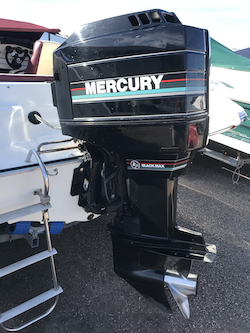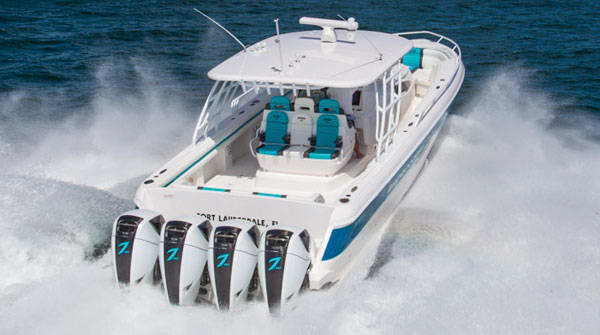Outboards vs Inboards
Get your motor running
Outboard engines
Outboards are purpose-designed and pack a lot of mechanical sophistication into a relatively small package. They range from small portable units producing a few horsepower, all the way to supercharged V8 monsters producing 500 horsepower or more. Diesel outboards are starting to appear but they are aimed firmly at the commercial market.
Outboards draw in water through the leg to cool the engine and have a hydraulic ‘tilt and trim’ mechanism. This allows you to lift the outboard leg so it’s completely out of the water. Exhaust gases exit down the leg and out through the propeller.
These days most outboards are 4-stroke petrol - they have valve timing gear, cambelts and a wet sump like a modern car engine. Many 2-stroke outboards are still around but there are few manufacturers of new 2-strokes. Special 2-stroke oil needs to be mixed with petrol to provide lubrication, but ‘oil injection’ systems on some outboards do this automatically from a remote tank.

Many older 2-stroke outboards are still in service - they have a reputation for longevity if looked after. My boat has a 1992 Mercury Blackmax - a 2.5 litre V6 2-stroke with oil injection. It has carbs rather than fuel injection and is rated at 150 horsepower.
Pros associated with outboards:-
- Designed for marine use
- Can tilt completely out of the water
- Relatively easy to ‘re-engine’ just lift off and attach a new one
- High power to weight ratio, especially from larger (older) 2-strokes
- Easy to maintain (especially 2-strokes)
- Don’t take up space inside the boat
Outboards are prone to theft so make sure you fit a good outboard lock.
Inboard engines
These are installed inside the boat and they can take up quite a lot of space. They connect to a sterndrive or outdrive housing the propeller and tilt and trim mechanism. Mechanically, this is a lot more complex than an outboard, and the maintenance costs are therefore likely to be higher.

Inboard engines are often petrol or diesel car engines adapted for marine use. Cooling is provided directly via water drawn through the sterndrive - raw water cooling - or indirectly by including a heat exchanger in the cooling circuit. Exhaust is either fed via the sterndrive and exits through the prop like an outboard, or uses through-hull exhaust pipes.
Pros associated with inboards:-
- Less vulnerable to theft than outboards
- Diesel engines can be more economical than petrol, however the increased maintenance costs likely cancel this out
- Car-derived engines may be more familiar to the home mechanic
- There is nothing quite like the sound of a V8 big block engine with through-hull exhausts
One lump or two?
You will see US boats fitted with three, four, or even five huge outboards. Cheaper fuel is one reason for this along with the trend for outboards on bigger and bigger boats.

Do you need more than one engine? As a budget boater I would say you certainly do not.
Fossil-fueled engines are increasingly efficient but they still turn a large proportion of potential energy into heat rather than propulsion. Add another engine and you are doubling your losses. You are also doubling your maintenance costs and your overall fuel consumption will increase.
Why do so many boats have twin engines? Boats above 24ft typically need a lot of speed to get on plane, and that speed typically requires two engines. It’s also easier to turn a large boat in a confined space when you have two engines - put one in forward gear and the other in reverse and you’ll turn on the spot.
Twin engines mean you can still get home if one engine fails, but unless you keep both engines well maintained you are more likely to experience a breakdown at some point. If you are worried about this in a smaller boat you can mount an auxiliary outboard bracket and carry a small backup outboard.
Winter is coming
In our climate boats usually need to be winterised at the end of the season (Oct/Nov) and then put back in commission after winter.
Winterising is easy if you have an outboard powered boat on a trailer. Just make sure the outboard is vertical so all the water drains out, treat any fuel left in the tank and stick the battery on a trickle charge. Some modern outboards can winterise and de-winterise themselves at the touch of a button.
Things are more complicated with an inboard. You need to make sure there is no chance of any water in the engine block freezing in cold temperatures. This can cause the engine block or the head to crack and you will be looking at a new engine. Winterising an inboard engine usually involves isolating the cooling circuit and filling it with a coolant mixture.
Budget option
For budget boats in the 14-20ft range a single outboard is more than adequate. A well-maintained 2-stroke will be relatively cheap to maintain, though they do consume more fuel than an equivalent 4-stroke. As they are likely to be older, sourcing spare parts for a 2-stroke may be an issue.
For the budget boater there are quite a few drawbacks with inboards - they are more complex, significantly heavier and take up valuable space inside the boat. If you are tempted by a boat with an inboard engine, make sure you add up the maintenance costs for the engine and sterndrive.